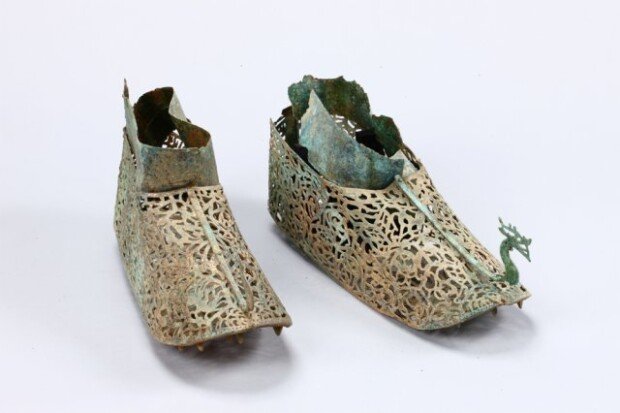Gilt bronze shoes from Baekje to be designated as national treasures
Gilt bronze shoes from Baekje to be designated as national treasures
Posted February. 17, 2021 07:35,
Updated February. 17, 2021 07:35

Two pairs of gilt bronze shoes from the fifth-century Baekje – burial accessories during the era of the Three Kingdoms of Korea – will be designated as national treasures. Gilt bronze shoes are one of the most commonly found metal craft items buried in ancient tombs along with earrings, necklaces, and bracelets. This is the first time that gilt bronze shoes are announced to be designated as national treasures.
“Two pairs of Baekje gilt bronze shoes each discovered from the tomb No. 1 at Bongdeok village in, Gochang County, North Jeolla Province and the Jeongchon tomb in Naju, South Jeolla Province will be designated as national treasures,” the Cultural Heritage Administration said on Tuesday. According to the CHA, over 30 gilt bronze shoes were found in ancient tombs of Baekje, Silla, and Goguryeo. The two pairs to be designated as national treasures are rare cases in which their shapes have been exceptionally well preserved.
The shoes excavated from the tomb No. 1 in Bongdeok, Gochang County are ceremonial items worn by the deceased of the ruling class at a funeral in the mid-fifth century. “They are thought to have been made by the central government of Baekje and given to a major local figure in power,” said Professor Lee Han-sang of the history and culture department at Daejeon University. The overall shape is similar to a boat and they are decorated with dragon, lotus, and other patterns. They also have spikes on the bottom, which is typical for gilt bronze shoes in the Baekje era.
The pair from the Jeongchon tomb in Naju is estimated to have been made a little later than the Bongdeok village pair in the late fifth century. The dragon head decoration attached to the top side of the shoes is unique among all gilt bronze shoes found so far. The Naju National Research Institute of Cultural Heritage recently said they belonged to a woman in her 40s.
beborn@donga.com







